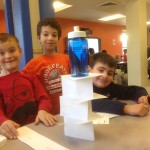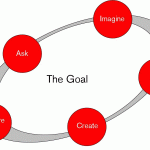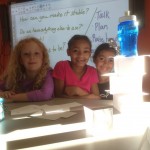Throughout the year, our students participate in many different performance tasks, activities that challenge students use the information they have learned to solve a problem or create a solution. At Discovery Academy, we are using the ENGINEERING PROCESS to work through these challenging activities. One such activity was a tower building problem that our second graders worked through as part of our Invention Convention work. First students had to ASK QUESTIONS: “How big does this tower need to be?” “What materials will we use?” Next the students had to IMAGINE and PLAN out their design. They discussed possible solutions in a group and explained their thinking to a teacher before receiving their supplies. Then the students CREATED a tower and tested it to see if it could hold weight. Finally, students IMPROVED their towers based on observations. This was a difficult task, but by using the engineering process, several groups were able to create a tower that met our challenge and many other groups were able to improve their designs and used their mistakes to revise their thinking.
If you are wondering the specifics of our challenge, just take 50 standard note cards, two feet of tape, and make them into a tower a foot high that can hold a standard water bottle.
Too often students see mistakes as examples of how they are “wrong” and “don’t get it.” Instead, we use the engineering process to show students that if you want to succeed, you have to use those mistakes to improve. As adults we are constantly having to problem solve and improve, but it can be hard to watch students struggle and fail at something. If we stand back and give them the tools and teach them to be persistent, to use those mistakes, we can teach them how to overcome their failures and use them to be successful.
Try using the language of the engineering process at home. Ask your student to imagine and plan before they work. Ask them how they can improve. Encourage your student to ask questions. Model the process yourself. The more they use these steps, the more they will see a challenge not as intimidating and impossible, but as exciting and attainable.
I’ve attached some pictures from our work below. It was pretty impressive to see them make it work.
- Success!
- The Engineering Process
- There were many mistakes before this success.



